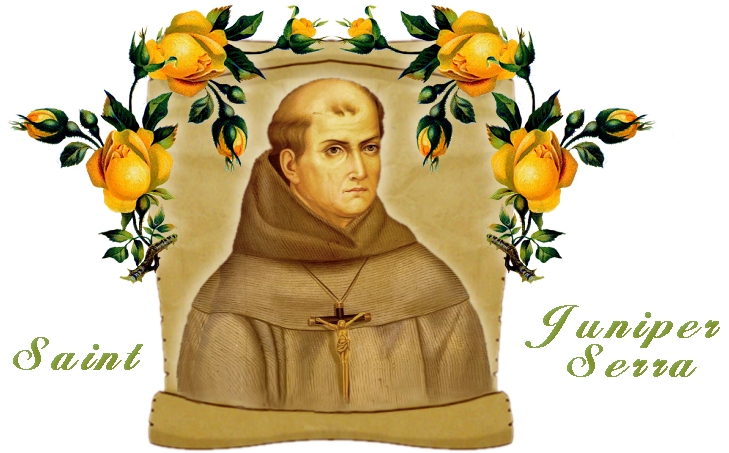  Bl. Juniper Serra July 1 A Spanish Franciscan priest, explorer and colonizer of California where he was the founder of the missions of California. He was beatified by Pope John Paul II in September 1988. We used the Saints banner in anticipation of his canonization. Fray Junípero Serra is known today as the "Apostle of California". His birthday is a public holiday in California, and grade school history texts detail his adventures and contributions to California history. A statue of his likeness stands in the Capitol Building in Washington D.C. He is patron and inspiration for 15,000 Catholic laymen who call themselves Serra International. Junípero Serra was born Miguel Serra y Abram on November 24, 1713 in Petra, a farming village in Mallorca's central plain. At the age of sixteen, Miguel entered the Franciscan friary and took the name Junípero, after St. Francis' close, extroverted friend. Years of formation and study followed, and in 1744 he was named Professor of Philosophy at the monastery of San Francisco and at Lullian University. Serra was known as a bright, articulate scholar and a moving speakeras well as a clear, precise writer; however, he did not remain long in academic life. In 1749 he responded to the call for Franciscan missionaries to the New World. Nearly 200 years before, Spain had established a colony called New Spain, the area now known as Mexico. The sucess of colonization was due largely to the collaboration of the Spanish imperial staff and the Catholic Church. By acting as partners in exploration and settlement efforts, both their purposes were achieved: Spain claimed new territory and the Catholic Church claimed new members. By the middle of the 18th century, Spanish cultural and religious influence was already evident in New Spain's great cathedrals, schools, hospitals, and seaports. However, this sophisticated civilization was restricted to urban centers such as Mexico City. The outlying areas were still uncharted and wild, and the Indians were still quite hostile towards the Spanish intruders. The unexplored areas were considered missionary territory. Serra's first assignment was to be rugged, mountainous region of Sierra Gorda. Here he remained for nine years, preaching to the Indians and strengthening the two missions already established in the area. Serra's second assignment was to journey out from Mexico City into coastal villages and mining camps. In those eight years, despite a leg chronically infected and ulcerated after an insect bite, he walked over 6,000 miles on foot, preaching retreats and administering the sacraments. In 1767 when the King of Spain banished the Jesuit Society from his dominions, the thirteen Jesuit missions in Baja California were suddenly left unstaffed. Junipero Serra was assigned the new Superior of Baja California, and within several years he was given orders to move into Alta California, or what today is known as the state of California. In 1769 Serra was appointed padre president of California. Serra joined the expedition of Don Gaspar de Pórtola, ordered by the Spanish king to explore and occupy new territory. He reached San Diego on June 27, 1769 and founded there the first mission. From San Diego the party journeyed northward and in April, 1770 Serra founded San Carlos Borromeo at Carmel, the second mission. In his fifteen years as padre president, he established nine of his 21 missions, (among them Santa Barbara, San Luis Rey and San Francisco de Asis, popularly known as Dolores) each a one-day walk apart (about 30 miles), and linked by a dirt road called "El Camino Real." Junípero Serra personally oversaw the planning, construction, and stuffing of each mission from his headquarters at Carmel. From Carmel he travelled on foot to the other missions along the California coast, to supervise mission work and to confer the sacrament of Confirmation. Biographers estimate that, still bothered by the infected leg, Serra walked more than 24,000 miles in California alone-----more than the journeys of Marco Polo and Lewis and Clark combined. He kept with determination to his watchword, "Always to go forward and never to turn back." The missions Serra founded had two purposes: to convert Indians to Catholicism, and to civilize these Indians by teaching them to farm and build. It was this two-fold purpose which caused Serra's impact to be felt both religiously and historically. And it was his unusual ability to accomplish these purposes peacefully, thet set him apart from other explorers. Each mission centered on a church structure, usually a wood frame topped with a thatched roof. However, when the church at San Luis Obispo burned after being showered by Indians' flaming arrows, all churches were rebuilt of adobe and stone. Indians fashioned rounded roof tiles by molding wet clay around their shins. Surrounding the church itself would be housing, areas for education of women and children, land cultivated for farming, and cattle-grazing areas. He died at Carmel on August 28, 1784.  HOME---------------PRAYERS AND DEVOTIONS-----------------LITANIES |
www.catholictradition.org/Saints/saints7-1.htm